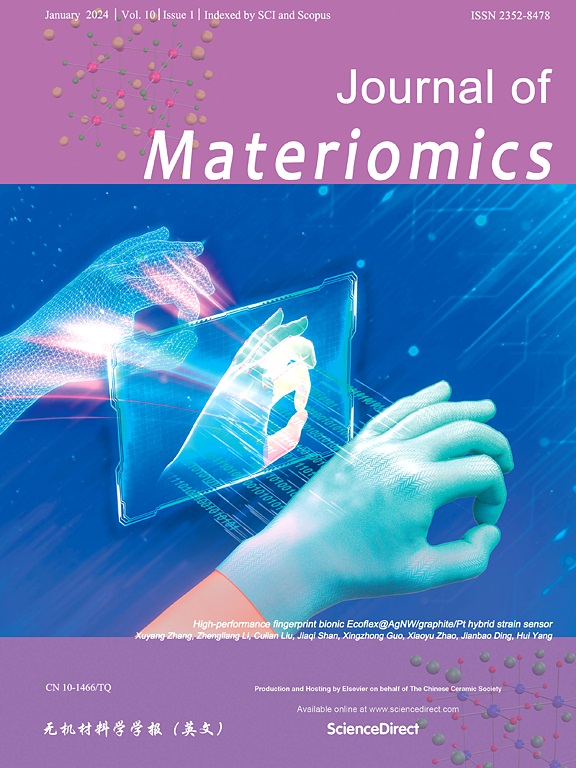基于cabi2nb2o9的高温压电陶瓷通过多场耦合策略实现了优异的高压电性综合性能
IF 9.6
1区 材料科学
Q1 CHEMISTRY, PHYSICAL
引用次数: 0
摘要
奥里维利相 CaBi2Nb2O9(CBNO)陶瓷的居里温度(Tc)超高,达到 934 ℃,在高温压电应用方面具有巨大潜力。然而,压电性低和电绝缘性差阻碍了它在高温传感领域的应用。在此,我们提出了一种有效的多场耦合策略,以协同优化 CBNO 陶瓷的压电特性、电导行为和温度稳定性。通过引入 Li/Pr 和 Bi/Sc 掺杂而构建的晶格应力和电场对晶格结构、微观结构、畴结构和缺陷化学有很大影响。因此,极化的增强、击穿电场的改善和纳米级畴的产生会显著提高压电活性(d33)。尤其是伪四方相界的存在有助于提高 d33。在所设计的 Ca1-3x(Li0.5Pr0.5)xBi2+2xNb2-xScxO9 体系中,x=0.02 陶瓷的 d33 高达 ∼18.2 pC/N,Tc 超高达 ∼938 °C。这与高电阻率(ρ∼1.72 MΩ cm,600 °C)和近乎稳定的 d33(高达 800 °C)相结合,表明它是一种非常有前途的高温(高达 600 °C或更高)传感应用压电材料。本文章由计算机程序翻译,如有差异,请以英文原文为准。


Achieving outstanding comprehensive performance with high piezoelectricity in CaBi2Nb2O9-based high-temperature piezoelectric ceramics via multi-field coupling strategy
Aurivillius phase CaBi2Nb2O9 (CBNO) ceramic with an ultrahigh Curie temperature (TC) of ∼934 °C shows huge potential in high-temperature piezoelectric applications. However, low piezoelectricity and poor electric insulation prevent its applications in high-temperature sensing. Here, we propose an effective multi-field coupling strategy to synergistically optimize piezoelectric property, electrical conduction behavior and temperature stability of CBNO ceramic. The constructed lattice stress and electric fields induced by introducing Li/Pr and Bi/Sc doping have great impacts on the lattice structure, microstructure, domain structure and defect chemistry. Therefore, a significant increase in piezoelectric activity (d33) is resulted from the enhancement of polarization, the improvement of breakdown electric field and the production of nanoscale domains. In especial, the existence of pseudo-tetragonal phase boundary is helpful for the enhanced d33. In the designed Ca1–3x (Li0.5Pr0.5)xBi2+2xNb2–xScxO9 system, a high d33 of ∼18.2 pC/N accompanied by an ultrahigh TC of ∼938 °C is achieved in the x = 0.02 ceramic. This combined with high electrical resistivity (ρ∼1.72 MΩ⋅cm at 600 °C) and nearly stable d33 (up to 800 °C) indicates that it is a very promising piezoelectric material for high-temperature (up to 600 °C or higher) sensing applications.
求助全文
通过发布文献求助,成功后即可免费获取论文全文。
去求助
来源期刊

Journal of Materiomics
Materials Science-Metals and Alloys
CiteScore
14.30
自引率
6.40%
发文量
331
审稿时长
37 days
期刊介绍:
The Journal of Materiomics is a peer-reviewed open-access journal that aims to serve as a forum for the continuous dissemination of research within the field of materials science. It particularly emphasizes systematic studies on the relationships between composition, processing, structure, property, and performance of advanced materials. The journal is supported by the Chinese Ceramic Society and is indexed in SCIE and Scopus. It is commonly referred to as J Materiomics.
 求助内容:
求助内容: 应助结果提醒方式:
应助结果提醒方式:


